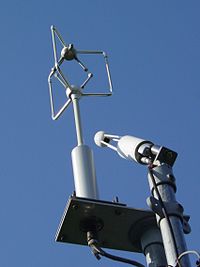
Photo from wikipedia
Turbulent eddies play a critical role in oceanic flows. Direct measurements of turbulent eddy fluxes beneath the sea surface were taken to study the direction of flux-carrying eddies as a… Click to show full abstract
Turbulent eddies play a critical role in oceanic flows. Direct measurements of turbulent eddy fluxes beneath the sea surface were taken to study the direction of flux-carrying eddies as a means of supplementing our understanding of vertical fluxes exchange processes and their relationship to tides. The observations were made at 32 Hz at a water depth of ~1.5 m near the coast of Sanya, China, using an eddy covariance system, which mainly consists of an acoustic doppler velocimeter (ADV) and a fast temperature sensor. The cospectra-fit method—an established semi-empirical model of boundary layer turbulence to the measured turbulent cospectra at frequencies below those of surface gravity waves—was used in the presence of surface gravity waves to quantify the turbulent eddy fluxes (including turbulent heat flux and Reynolds stress). As much as 87% of the total turbulent stress and 88% of the total turbulent heat flux were determined as being at band frequencies below those of surface gravity waves. Both the turbulent heat flux and Reynolds stress showed a daily successive variation; the former peaked during the low tide period and the later peaked during the ebb tide period. Estimation of roll-off wavenumbers, k 0 , and roll-off wavelengths, λ 0 (where λ 0 =2 π / k 0 ), which were estimated as the horizontal length scales of the dominant flux-carrying turbulent eddies, indicated that the λ 0 of the turbulent heat flux was approximately double that of the Reynolds stress. Wavelet analysis showed that both the turbulent heat flux and the Reynolds stress have a close relationship to the semi-diurnal and diurnal tides, and therefore indicate the energy that is transported from tides to turulence.
Journal Title: Acta Oceanologica Sinica
Year Published: 2020
Link to full text (if available)
Share on Social Media: Sign Up to like & get
recommendations!